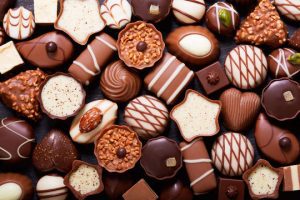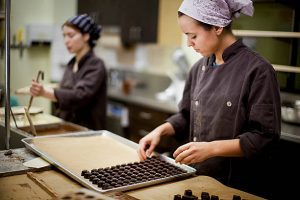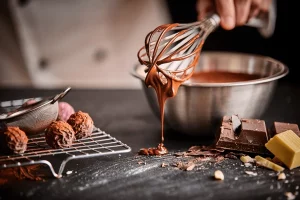Chocolate: Global Treasure
Chocolate is more than a sweet treat; it’s a crossroads of agriculture, chemistry, craftsmanship, and culture. From sacred Mesoamerican ceremonies to modern bean-to-bar ateliers, cacao’s story blends sensory pleasure with centuries of innovation. Below, you’ll find a concise, link-free deep dive covering health benefits, the best sources to buy and enjoy, who grows it, a historical arc that includes cacao as currency among the Maya and Aztec peoples, notable chocolate devotees, and credible training paths for aspiring chocolatiers.
What chocolate is—and why it tastes so good
All chocolate begins with the seeds of Theobroma cacao. After harvest, fresh beans are fermented in their pulp, then dried, roasted, cracked, and ground into cocoa liquor. Pressing the liquor yields two main components: cocoa butter (the fat that gives chocolate its luscious melt) and cocoa solids (where flavor and polyphenols live). A finished bar combines cocoa liquor and cocoa butter with sugar and, sometimes, milk powder or vanilla. Fine makers control every step—fermentation style, roast profile, particle size, and conche time—because each variable reshapes aroma, texture, and flavor.
Evidence-based health benefits (and smart expectations)
The potential health upside of cocoa centers on flavanols, a class of polyphenols associated with improved endothelial function, modest blood pressure effects, and better insulin sensitivity in some studies. Dark chocolate also contains theobromine and a small amount of caffeine, mild stimulants that can enhance alertness. Still, moderation matters: typical confections come with sugar and calories. If you’re seeking wellness benefits, reach for high-cacao dark chocolate and non-alkalized cocoa powder, because heavy alkalization (“Dutching”) can significantly reduce flavanol content. Think of chocolate as a flavorful, nutrient-dense accent—not a supplement.
A practical cadence looks like this: a small square of 70–85% dark chocolate after meals, or a cup of hot cocoa made from natural (non-alkalized) powder and lightly sweetened. People managing reflux or migraines may wish to gauge sensitivity to theobromine and caffeine, and anyone counting calories should treat even dark chocolate as a mindful indulgence.
Best sources and styles to buy
If health, flavor, and ethics all matter to you, use this simple checklist:

- Choose your percentage wisely. Bars labeled 70–90% contain more cocoa and less sugar. Start around 70% and climb if you enjoy deeper intensity.
- Prefer short ingredient lists. Look for cocoa mass/liquor, cocoa butter, sugar, and perhaps real vanilla. Skip cheap added fats and unnecessary emulsifiers.
- Natural vs. alkalized powder. For higher flavanols, pick natural cocoa powder. For baking that needs deeper color and a smoother, less acidic taste, alkalized is fine—but it’s usually lower in flavanols.
- Explore single origins. Cacao from Madagascar can taste bright and berry-like; Ecuador often leans floral and nutty; Peru can be citrus-fruity; West Africa can be classic “chocolatey.” Origin teaches your palate.
- Bean-to-bar transparency. Makers who detail fermentations, roast profiles, and farmer partnerships typically chase quality and ethics in tandem.
Who grows the world’s cacao?
Cacao thrives near the equator, roughly twenty degrees north and south. Guatemala, Honduras, Côte d’Ivoire and Ghana have long been top producers. Other key origins include Indonesia, Ecuador, Brazil, Cameroon, Nigeria, Peru, Dominican Republic, and Colombia. Output shifts year to year with weather patterns, disease pressures (like swollen shoot virus and frosty pod rot), and market prices. Behind these numbers are millions of smallholder farmers. When possible, support programs that improve incomes, encourage agroforestry, and reduce deforestation; certifications and direct-trade models can help move the needle.
A brief history—cacao from ceremony to confection
Cacao’s story begins in ancient Mesoamerica. The Maya prepared a spiced, foamy chocolate drink for rituals, banquets, and social exchange. The Aztec elite also prized cacao beverages, often seasoned with chili, annatto, vanilla, and florals. Critically, cacao beans functioned as money in parts of pre- and early-colonial Mesoamerica: records describe beans exchanged for goods and even used alongside Spanish coinage in the 16th century. After contact, Europeans sweetened the bitter brew, added milk, and eventually learned to solidify and refine chocolate. By the Industrial Revolution, innovations like the cocoa press, conching, and standardized molding turned luxury service into mass enjoyment, paving the way for the global chocolate industry we know today.
Famous people who love chocolate
Chocolate’s allure has charmed royalty, writers, chefs, and entertainers for centuries. European courts employed personal chocolatiers to prepare fashionable drinking chocolate. Victorian and Edwardian social circles embraced elaborate chocolate desserts. Modern culinary icons—from pastry champions to television bakers—routinely celebrate chocolate’s versatility in ganaches, mousses, tarts, and glazes. The thread is consistent: across eras and continents, chocolate is a symbol of comfort, celebration, and creative expression.
Learning the craft—how to become a chocolatier
Becoming a great chocolatier blends science, technique, and artistry. You’ll need to master:
- Tempering: Creating stable cocoa-butter crystals (Form V) for gloss, snap, and shelf-life.

- Molding and enrobing: Getting thin, even shells and clean bottoms; managing cooling curves.
- Ganache formulation: Balancing water activity, fat content, and emulsification for texture and safety.
- Shelf-life and food safety: Using glucose, invert sugars, and alcohols to control water activity; understanding preservatives and packaging.
- Flavor architecture: Roasts, origins, inclusions, and textures that layer into a signature style.
- Operations: Costing, batch planning, HACCP, and packaging design.
Respected training paths include international chocolate schools run by major houses and independent academies with apprenticeship options. Many aspiring chocolatiers start with intensive short courses, then embed with a bean-to-bar maker or high-end pâtisserie to refine speed and consistency. Origin travel—observing fermentation and drying at farms or cooperatives—adds invaluable perspective. Round out your toolkit with classes in sensory analysis, confection shelf-life, and business fundamentals so your artistry can scale.
Tasting and storing like a pro
- Room matters. Taste in a neutral, unscented space. Strong aromas (coffee, candles, perfume) mask nuance.
- Let it melt. Snap a piece, note the aroma, then hold it on your tongue and breathe through your nose to capture volatile compounds.
- Mind the pairing. Water clears the palate best. Coffee, tea, and spirits can be wonderful but will steer the experience.
- Storage. Keep bars cool, dry, and dark—ideally 15–18°C. Avoid refrigeration if possible, as condensation can dull shine and bloom sugar.
Quick buyer’s mini-guide
- Pick 70–85% dark to balance intensity and approachability.
- For health emphasis, choose non-alkalized cocoa powder and high-cacao bars.
- Explore single-origin bars to learn terroir.

- Support transparent sourcing programs that value farmers and forests.
- For baking, match cocoa types to goals: natural for tang and lift with baking soda; alkalized for color and milder flavor.
A thoughtful final note
Chocolate’s magic lies in contrast: ephemeral melt, persistent aroma; ancient ritual, modern precision. When you savor a square, you’re tasting a chain of human skill—from farmers guiding fermentation to craftspeople tuned to the delicate dance of tempering. Choose mindfully, enjoy slowly, and if curiosity calls, apprentice yourself to the craft and join a tradition that spans continents and centuries.
References:
https://www.history.com/articles/history-of-chocolate
https://www.english-heritage.org.uk/easter/the-history-of-chocolate
https://www.icco.org/may-2025-quarterly-bulletin-of-cocoa-statistics/
https://worldpopulationreview.com/country-rankings/cocoa-producing-countries
https://riskmap.fairtrade.net/commodities/cocoa
https://news.harvard.edu/gazette/story/2025/09/you-want-chocolate-you-need-flavanols/
https://www.fda.gov/food/hfp-constituent-updates/fda-announces-qualified-health-claim-cocoa-flavanols-high-flavanol-cocoa-powder-and-reduced-risk
https://pmc.ncbi.nlm.nih.gov/articles/PMC9698929/
https://www.valrhona.com/en/l-ecole-valrhona/our-professional-classes/professional-classes
https://www.callebaut.com/en-US/callebaut-chocolate-academy
https://www.ecolechocolat.com/en/french-chocolate.html








